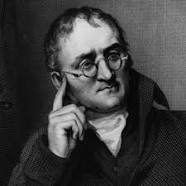Science > Chemistry > Laws of Chemical Combinations > Dalton’s Atomic Theory
In this article, we shall study the meaning of physical changes and chemical changes, and the very important concept of chemistry known as dalton’s atomic theory which became a stepping stone in the development of chemistry.
Physical Changes and Chemical Changes:
Physical Changes:
Physical changes are those changes in which there is an only change in the appearance of the substance but no change in its chemical composition.
Examples:
- Melting of ice
- Boiling of water
- Chopping of wood
- Heating of tungsten wire to red hot condition.
- Mixture of two non-reacting solids
Chemical Changes:
Chemical changes are those changes which cause a change in chemical composition of a substance and entirely new substance is formed.
Examples:
- Burning wood
- Souring milk
- Neutralization of acid using base
- Digesting food
- Cooking an egg
- Rusting of iron
Distinguishing Between Physical Changes and Chemical Changes:
| Physical Change | Chemical Change |
| Physical changes are those changes in which there is an only change in the appearance of the substance but no change in its chemical composition. | Chemical changes are those changes which cause a change in chemical composition of a substance. |
| No new substance is formed | Entirely new substance (one or more) is formed. |
| There is only rearrangement of molecules while their actual composition remains same. | The molecular composition of a substance changes completely |
| Physical change is reversible and original substance can be recovered. | Chemical change is irreversible and original substance cannot be recovered. |
| In a physical change, no energy is produced. | In a chemical change, energy is produced (heat, light, sound, etc.) |
| There is negligible change in enthalpy of the system in physical change. | There is enthalpy change in chemical change. |
| During physical change physical properties like phase, texture, shape, size, etc. change | During chemical change both physical and chemical properties of the substance change. |
| Examples: Freezing of water, melting of ice, Heating of tungsten wire to red hot condition. | Examples: Rusting of iron, burning of wood, digestion of food, etc. |
The Phlogiston Theory:
The theory stated that the substance undergoing combustion mainly contains a mysterious matter called phlogiston and some clax. If a substance is burnt, phlogiston evolves and goes into atmosphere and clax (meaning a non-useful thing) is left behind as an ash.
When a candle burns in a closed container, the air in the container becomes saturated with phlogiston. Air cannot accommodate additional phlogiston and the candle is extinguished.
Wood (Phlogiston rich) → Burnt → Phlogiston in air + Clax (ash)
Challenges to the Phlogiston Theory:
In 1771 British chemist Joseph Priestley heating mercury oxide produced a gas (oxygen) and found that a candle burns vigorously in this gas than that in the air. He named this gas as dephlogisticated air.
In 1766, Sir Henry Cavendish produced another gas (Hydrogen) by the action of an acid with metal. He found that this gas burns in air and produce water. He called this gas as flammable air. He further said that flammable air must be associated with the phlogiston.
French scientist Lavoisier ruled out the theory of phlogiston and proved that during burning a part of the air is used in the chemical reaction. He named this part of the gas as oxygen (acid forming). He also proved that the gas produced by Cavendish has nothing to do with phlogiston and called this gas as hydrogen (water forming).
Burning substance + Part of air (oxygen) → Ash
Dalton’s Atomic Theory:
Assumptions of Dalton’s Atomic Theory:

- Every element is made up of extremely small particles called an atom.
- The atoms are indivisible and they can neither be created nor be destroyed. Atoms of the same element resemble each other in all respects but differ from the atoms of other elements.
- When chemical compounds are formed they do so by the combination of atoms of different elements in a simple proportion of whole numbers.
- Atoms of different elements may combine in more than one proportion to form different compounds.
- The combining weights of the elements represent the combining weights of the atoms.
Limitations of Dalton’s Atomic Theory:
- Now it is proved that the atom consists of particles like electrons, protons, and neutrons. Thus the assumption of Dalton’s theory that the atom is not divisible is false.
- Discovery of isotopes revealed that the atoms of the same element possess different weights. Thus the assumption of Dalton’s theory that the atoms of the same element are identical in all respect is false.
The Review of Dalton’s Atomic Theory:
Every element is made up of extremely small particles called an atom. The atoms are indivisible.
Modern Concept: Atoms are not the smallest particles. They can be further divided into subatomic particles like protons, neutrons, and electrons.
Atoms can neither be created nor be destroyed.
Modern Concept: With the advent of nuclear chemistry, atoms of one element can be converted into atom of another element by transmutation.
Atoms of the same element resemble each other in all respects;
Modern Concept: With the knowledge of isotopes we can have atoms of same elements having the same atomic number but different mass number. Thus atoms of the same element may not resemble each other in all respects;
Atoms of the different element differ from the atoms of other elements.
Modern Concept: There are certain elements; with the difference in their atomic number have the same mass number. Thus atoms of different elements may resemble in some properties
Dalton didn’t consider the mass-energy relation. According to Einstein’s theory in a chemical reaction, some mass is getting converted into energy.
In the next article, we shall study the law of conservation of mass.
Last Chapter: Introduction to Chemistry
Next Topic: Law of Conservation of Mass